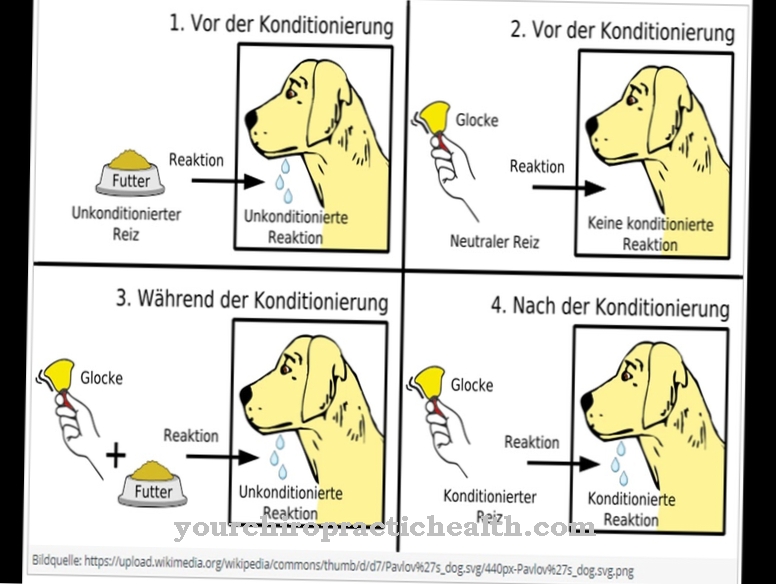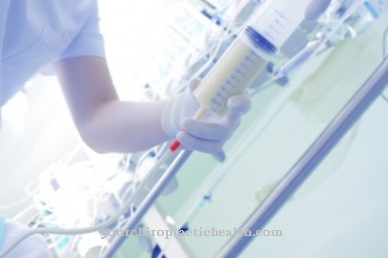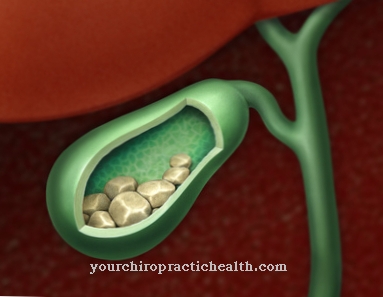Of the Minor test serves to make increased perspiration on the human body visible. A specially mixed iodine solution is evenly brushed onto the skin.
Usually it is a mixture of iodine or potassium iodide, glycerine or castor and alcohol. As soon as the solution has dried, it is powdered with a starch powder or quinizarin. The next step is to induce profuse sweating by administering aspirin or linden blossom tea. Parts of the body that are particularly sweaty then turn blue to black.
Small dots emerge on a white background, which increase in size over time and merge (confluence). The method is particularly used when patients suffer from increased sweat gland activity in the armpit area. The discoloration is particularly noticeable there. The minor test often also indicates increased perspiration on the hands. Of the Iodine Strength Test was introduced in 1928 and named after its first user, Minor.
What is the minor test?
The chemical mixture used is also called Lugol's solution. It was invented in 1835 by the French doctor Jean Guillaume Lugol. Her Latin name is Solutio Lugoli. In its original form it is a solution of iodine in water to which potassium iodide has been added.
Lugol's solution is used for a wide variety of purposes in chemistry and medicine, including the detection of chitin or alkaloids and as a disinfectant. It is brownish-red in color and has the typical iodine odor. The classic mixing ratio is 1: 2 iodine to potassium iodide in water. The color reaction in the minor test on the skin is based on the storage of iodine ions in starch molecules. The Achenbach method is known as a modification of the minor test, in which starchy paper is used that is impregnated with iodine crystals.
If this paper is placed on heavily sweating skin areas, it will change color accordingly. This modified test is repeated at certain time intervals in order to clarify an improvement in the situation. If this occurs, the blue to black discolored area shrinks over time. The minor test is still the leading method for verifying hyperhidrosis, i.e. excessive sweat production. It can occur locally, especially under the arms, on the hands and feet, but it can also affect the entire body, including the face.
When performing the minor test, it is crucial to thoroughly dry the excessively sweaty skin area before applying Lugol's solution. This is the only way to precisely visualize the affected areas of the body. In addition, gravimetry can be used to precisely determine the amount of sweat that is secreted in a certain time. A special filter paper is used here to soak up sweat. It is then weighed with an ultra-fine balance. However, no limit values have been set for the result that could be relevant for a possible treatment.
Function, effect & goals
It is estimated that one to two percent of the entire population in Germany is affected by hyperhidrosis. This disease usually occurs regardless of the temperature and the time of day or season.
The strong perspiration cannot be consciously controlled without aids. Heavy sweating occurs 60 percent on the hands and feet, 40 percent in the armpits and ten percent on the head or forehead. For those affected, excessive sweating is always determined by subjective assessment and personal distress. In science, hyperhidrosis is understood to mean the production of a total of 100 milligrams of sweat in an armpit over a period of five minutes. Apart from such values: sweating is vital for the human organism because it helps to regulate body temperature. Not only the skin is cooled, but also the inside of the body including all organs.
You can find your medication here
➔ Drugs against sweating and sweatingRisks, side effects & dangers
The excessive production of sweat can be congenital and in this case it is called primary hyperhidrosis. This is usually noticeable in childhood and adolescence, occurs unpredictably and cannot be controlled.
Secondary hyperhidrosis, on the other hand, is always the result of a disease, mostly of the circulatory system. In so-called bromhidrosis, the excess sweat moistens the horny layer of the skin and thus contributes to the multiplication of bacterial flora, which causes an unmistakable bad odor. In relation to the armpits, the minor test can provide valuable information about the extent of hyperhidrosis. It is classified as strong if the sweat areas under the arms are larger than 8 inches and sweat drips off the palms and feet. In addition, generalized hyperhidrosis occurs, for example during great physical exertion or during what is known as a fever.
In both cases, sweating is a regulation of body temperature that has risen above normal. The increased sweat production gives off excessive heat to the environment. However, the minor test does not provide any information about the reasons for repeated profuse sweating. For example, hyperhidrosis can have hormonal causes. These may have something to do with menopause, an overactive thyroid or, in rarer cases, with adrenaline-emitting tumors. Circulatory weaknesses and, more often, overweight are also natural reasons for the constant increased perspiration. Often this is exacerbated by psychological problems or disorders as well as particularly stressful stress cases.



























